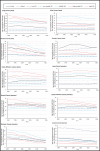Epidemiological science and cancer control
- PMID: 30281702
- PMCID: PMC6142858
- DOI: 10.6061/clinics/2018/e627s
Epidemiological science and cancer control
Abstract
Epidemiological methods are essential for the discovery of cancer risks and prognostic factors as well as for the evaluation of cancer prevention measures. In this review, we discuss epidemiological surveillance procedures for data collection and processing to guide and evaluate the consequences of anticancer efforts for populations, assess the identification of cancer risk factors, examine barriers to cancer screening and recommended rules for early diagnosis programs. Epidemiological studies have shown that hindrances to cancer information assessment are currently encountered in developing countries. Known cancer risk factors include social determinants, lifestyle factors, occupational exposures, infectious agents, and genetic and epigenetic alterations. Challenges remain in studying the effectiveness of cancer screening; screening can have detrimental effects, and few cancers clearly benefit from screening. Currently, epidemiology faces the challenge of dealing with distinct levels of data, including factors related to social status, lifestyle and genetics, to reconstruct the causal traits of cancer. Additionally, translating epidemiological knowledge into cancer control demands more implementation studies in the population.
Conflict of interest statement
No potential conflict of interest was reported.
Figures
References
-
- Porta M. A dictionary of epidemiology. New York: Oxford University Press; 2014. 5th ed. - DOI
-
- World Health Organization . 2005. WHA58.22 Cancer prevention and control. In: World Health Assembly [Internet] pp. p. 1–5. Available from: http://www.who.int/cancer/media/news/WHA58 22-en.pdf?ua=1.
-
- World Health Organization . Cancer control: knowledge into action: WHO guide for effective programmes. Geneva: WHO Press; 2006.
-
- Hiatt RA, Rimer BK. A new strategy for cancer control research. Cancer Epidemiol Biomarkers Prev. 1999;8((11)):957–64. - PubMed
Publication types
MeSH terms
LinkOut - more resources
Full Text Sources


